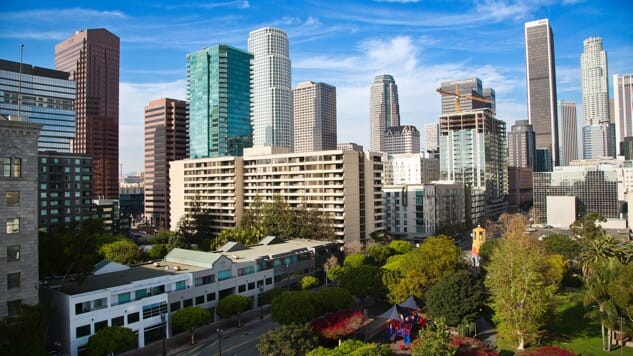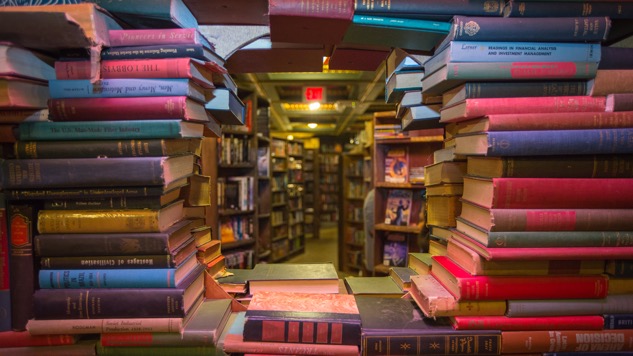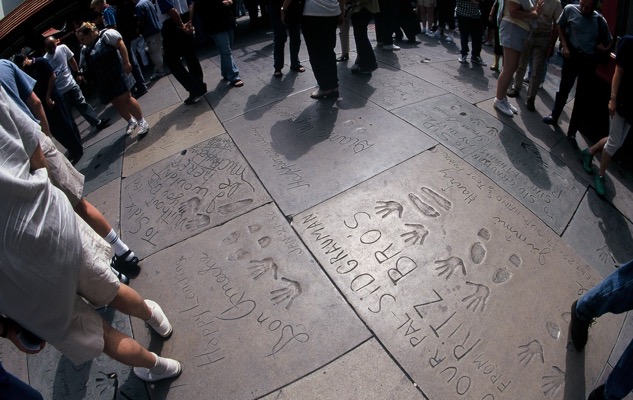Transit Authority: Explore LA on the Red Line
Photos: Los Angeles Tourism & Convention Board Travel Features
The Great American Streetcar Scandal is a conspiracy theory that suggests car companies intentionally bought and dismantled streetcar systems in major cities to force people to buy more automobiles. While the authenticity of the claim is hotly debated, it is true that the Red Car (a.k.a. Pacific Electric) was a massive electric railway system in Los Angeles that eclipsed the NYC subway in the 1920s yet quickly declined in popularity as automobiles became more common. By April 1961, the last operating stretch of passenger rail made its final run. A full generation later, the Los Angeles subway system is back, and the Red Line travels the same route as the Red Car during the Golden Age of Hollywood.
Stretching from Union Station downtown to North Hollywood in the San Fernando Valley, the Red Line is the most-travelled subway line in Los Angeles with nearly 4 million riders in January 2017. By comparison, the Blue Line had the second-highest number with 2 million. The popular 17-mile system cuts through the heart of Hollywood making it one of the best lines for exploring tinsel town. Buy an unlimited-use day pass ($7 as of March 2017) and start at Union Station.
Union Station
What do Blade Runner, Silver Streak and To Live and Die in LA all have in common? Scenes from each movie were filmed at Union Station, a railway hub built in the 1930s by the same people behind Los Angeles City Hall and Bullocks Wilshire. The Mission Moderne-style station regularly holds music, art and food events, and its bike-share program allows people to explore the area more extensively.
The century-old Philippe the Original deli just north of the station claims to have invented the French dip sandwich—a claim disputed by Cole’s a mile south—but save your appetite for Olvera Street across from the station. The so-called “birthplace of Los Angeles” is a long, picturesque street that honors the city’s Mexican heritage with a marketplace, restaurants, street vendors, art murals and 19th-century structures. Founded in 1781 and renamed a century later, “Los Angeles’ first street” appears in Charlie Chaplin’s 1921 movie The Kid.
Civic Center/Grand Park
The area around this station offers rustic farm-to-table gastronomy at Otium and likeable selfie opportunities at City Hall, Grand Park and the Frank Gehry-designed Walt Disney Music Hall. Still, the hottest attraction right now is The Broad, a new 120,000-square-foot art museum that offers free general admission, but save time by reserving free tickets in advance on the museum website.
Pershing Square
Pershing Square is a former settlers camp that became a public space in the 1860s and went by names like Los Angeles Park and Central Park before being renamed in honor of General John Pershing after World War I. In the early 1990s, the city spent several million dollars renovating Pershing Square, which now features fountains, a large bell tower, public art, a concert stage and a seasonal ice rink. Surrounded by tall buildings, the colorful square provides lots of photo opportunities and eye-of-the-storm tranquility in a sea of downtown chaos.

The Last Bookstore
The Broadway Theater District, one block east on South Broadway, is lined with historic buildings and performance halls that recall the entertainment industry in its early 20th-century heyday. South Broadway is also home to the century-old Grand Central Market with gourmet food stalls like G&B Coffee, Horse Thief barbecue and Eggslut. The Last Bookstore, featuring one of the city’s largest collections of used books and vinyl, sits just east of the station, while the Millennium Biltmore Hotel bar is the place for a classic cocktail. Built nearly a century ago, the Biltmore was an early home for the Academy Awards and where John F. Kennedy accepted the democratic presidential nomination in 1960, and the Beatles famously visited the hotel by helicopter in 1964 when fans made it impossible to enter from the street.
7th Street/Metro Center
The Metro Center station—shared by the Expo Line four blocks north of the Staples Center, L.A. Live, the Microsoft Theater and the Los Angeles Convention Center. Closer to the station are options like the Diplomat Cigar Shop, the Honeycut bar and the industrial-style Faith & Flower restaurant famous for its award-winning English Milk Punch with eight different spirits.
Westlake/MacArthur Park
In the early 1940s, Westlake Park was renamed in honor of General Douglas MacArthur, and it gained pop-culture fame when Richard Harris nearly topped the Hot 100 with the 1968 hit “MacArthur Park.” A decade later, the song finally did hit No. 1 when Donna Summer recorded a disco version. Saturday Night Live, Weird Al and The Simpsons all spoofed the song, and Dave Barry’s Book of Bad Songs listed it as the worst song of all time. For a slightly more contemporary pop-culture reference, MacArthur Park and the station appear in the 1997 film Volcano in which an eruption destroyed a Red Line train, among other things. In years past, MacArthur Park was a gang-infested area packed with drugs and prostitution, and a few people drowned (with a little help) in its Central Park-like lake. The area is much safer now, but stick to a daytime visit.
Wilshire/Vermont
This station is your gateway into L.A.’s beloved Koreatown. History buffs should head a few blocks west to the Ambassador Hotel, home to the second Academy Awards and the 1968 assassination of presidential candidate Bobby Kennedy. The neighborhood’s main draw, however, is a vibrant food scene highlighted by acclaimed newcomer Here’s Looking at You, the Korean BBQ Genwa and the diet-busting Beer Belly where deep-fried pop tarts and Lucky Charms pancakes are more than just a little boy’s fantasy. Latinos actually outnumber Koreans in Koreatown, which accounts for restaurants like EscaLA serving Colombian-Korean fusion.
Vermont/Beverly
The multicultural Karma Lounge sits a few blocks west on Beverly Boulevard, but those who are not desperate for a drink can skip this stop.
Vermont/Santa Monica
Los Angeles City College, the Guatemalteca bakery, several Filipino restaurants and a prohibition-style saloon called The Virgil are all nearby, but most travelers should skip ahead to the next station.
Vermont/Sunset
One block north, Barnsdall Art Park is home to the Hollyhock House, Frank Lloyd Wright’s first Los Angeles design project built nearly a century ago for oil heiress Aline Barnsdall. Walk to Hollywood Boulevard for La Luz de Jesus, the gallery that helped launch the lowbrow art movement, while Swingers fans will want a martini at The Dresden on North Vermont Avenue.
Hollywood/Western
Unless you need a Starbucks fix, skip this station.
Hollywood/Vine
The entertainment industry in the 1920s thrived at the intersection of Hollywood Boulevard and Vine Street, which is now the center of the Hollywood Walk of Fame. Look south down Vine Street to see the iconic Capitol Records Tower, and head one block east to find the historic Pantages Theatre and Frolic Room. Completed in 1930, Pantages originally hosted live vaudeville performances and currently attracts top Broadway productions that will include Hamilton, The Book of Mormon and An American in Paris in 2017. On the music side, the Talking Heads’ shot the 1984 concert film Stop Making Sense at the Pantages, and the Academy Awards took place here during the 1950s.
Adjacent to the Pantages Theatre is the Frolic Room, which supposedly started out as a celebrity-packed speakeasy during prohibition. The Frolic Room went aboveboard in 1934, and Howard Hughes (who owned the theater and bar for a time) apparently threw some wild parties inside its walls. The Frolic Room appears in Hollywood noir murder-mysteries like LA Confidential and The Black Dahlia, and the bar was the last place anyone saw Elizabeth Short (a.k.a. Black Dahlia) alive before her 1947 murder. Like any good dive bar, the Frolic Room opens early at 11 a.m.
Hollywood/Highland

Hand- and footprints in front of TCL Chinese Theatre
Welcome to L.A.’s answer to Times Square (not that any local asked why we didn’t have one). Expect crowds of tourists, hideous sightseeing buses and dead-eyed men in superhero costumes taking pictures with nose-wiping kids. Those who can endure the street-spreading horde should head east to the landmark Egyptian Theatre, which opened in 1922 shortly before archeologists discovered King Tut’s tomb in Egypt. The theater screened the film Robin Hood, featuring Douglas Fairbanks in the title role, in 1922 for what was the first-ever Hollywood premiere.
Sid Grauman, who built the Egyptian, followed with El Capitan in 1926 and the TCL Chinese Theatre in 1927, all of which reside on Hollywood Boulevard. The grand Chinese Theatre, located inside the Hollywood and Highland Center, is arguably the best place to see a movie thanks to meticulous ornate design and the world’s largest IMAX auditorium. Many top films held premieres here, including Star Wars and The Wizard of Oz, with stars walking down a yellow-brick road for the latter. This is also the place where celebrities leave hand and foot imprints in the cement. The Academy Awards were held here a few times in the 1940s—and the first-ever ceremony was held across the street at the Roosevelt Hotel—but the Oscars ceremony now has a permanent home at the Dolby Theatre next door.
The Hollywood and Highland Center has several dining options, but the best choice is Mamacita on the top level. This brand-new Peruvian joint serves gourmet bowls and wraps in a casual yet artistic setting.
Universal City/Studio City
From the heart of Hollywood, the Red Line travels through the eastern Santa Monica Mountains into the San Fernando Valley. Exit the Universal City station for a stroll down Universal CityWalk with shopping, eating and movies aimed at generic tourists in Bermuda shorts and Old Navy tees. Those willing to traverse the entire CityWalk will arrive at Universal Studio Hollywood, a film studio and theme park with attractions based on Harry Potter, The Simpsons, Transformers and The Walking Dead, among other franchises.
North Hollywood
You’ve reached the end of the line and the heart of the NoHo Arts District. This neighborhood contains art galleries, theaters and restaurants like the Republic of Pie and The Federal Bar where Belching Beaver beer and blue crab mac ‘n’ cheese are a thing. Music recording studios abound in North Hollywood, and while none of its hotels ever hosted the Academy Awards, you will find the Television Academy where they produce the Primetime Emmy Awards. With so much Hollywood history all around, you might want to travel the Red Line like a local and carry an 8” x 10” headshot.
Top image: LA skyline
David Jenison is a Los Angeles native and the editor-in-chief of PROHBTD. He has covered entertainment, restaurants and travel for more than 20 years.